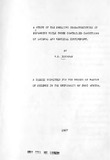| dc.description.abstract | Expansive clays cause considerable damage to structures erected on them. Moisture variations cause these soil6 to expand and shrink, producing differential heaving, detrimental to buildings. A similar problem is also encountered in roads and airfield construction, where moisture variations in the compacted subgrade cause volume changes and subsequent waving of the paved surface. The expansive clays are particularly detrimental to hydraulic structures placed on them. The degree of expansion, the uplift pressures and loss of stability are great because of the presence of water which eventually saturates the soil.
The possibility of damage to structures due to swelling of clays is complicated by the problem of identifying those soils likely to possess undesirable characteristics. Some research has been carried out by various investigators to develop a reliable means of predicting the potential expansion characteristics of clays. Microscopic examinations, X-ray diffraction determinations and differential thermal analysis are valuable to determine the presence of objectionable
clay minerals which may ultimately cause expansion.
A number of empirical approaches, based on the use of index tests, have been developed as an aid to anticipate the
-2-
expansion characteristics. A simple free swell test provides a quick qualitative means of assessing expansiveness.
Indices such as liquid limit, plastic limit, shrinkage limit and percentage clay fraction are good indicators of expansion characteristics of clays when considered together. It is suggested that the shrinkage index (defined as liquid limit minus shrinkage limit) and the percentage clay fraction may be a reliable index to evaluate qualii-atively the swelling potential of a soil. Other indices used as an aid in this respect are linear shrinkage, specific surface area, and heat of wetting.
The relative importance of each of these indices with regard to the expansion properties has been discussed.
Some research has been carried out by various investigators to study the swelling and the swelling pressures developed in a soil under various conditions of confinement. It has been found that moisture, density and soil structure are among the most important factors influencing volume change. In the present study, laboratory tests were carried out to study the swelling characteristics of expansive soils. Tests were carried out by two different methods - (a) Indirect method and (b) Direct method. In the indirect method, a standard consolidometer with suitable
-3-
modifications was used to study the rate and amount of swell under various conditions of initial dry density, initial moisture content, and applied load. The data shows that the amount of swell is inversely proportional to the restraining pressure. From the tests, an attempt was made to deduce the maximum balancing swelling pressure, i.e. the pressure at which the sample undergoes no volume change under the particular conditions of confinement. It has been observed that if the soil i6 at a low initial dry density and low initial moisture content, and it is subjected to heavy initial load, very high swelling pressures develop with increase in moisture content.
In the direct method, the tests were carried out in an apparatus specially designed to find the absolute maximum swelling pressures developed in a soil under complete lateral and vertical confinement. This apparatus could also be conveniently used to find the swelling pressures developed in a soil, after allowing it to expand vertically to a predetermined value. It has been found that the swelling pressures are greatly reduced if expansive soils are permitted to swell a little. The rate of build up of pressure and the maximum pressure developed in a soil under conditions of complete lateral and vertical
- k -
confinement and at various values of initial dry density and initial moisture content were observed.
The results obtained by the two methods for the determination of swelling pressure developed under conditions of complete confinement were compared and they showed good agreement. An effort was made to study the relationships between swelling pressure, initial dry density, initial moisture content, and volume change. The data shows the significant effect of dry density and moisture content on swelling pressures. A straight-line relationship between swelling pressure and initial moisture content was obtained. From the limited data, it seems that there may be no consistent relationship between the swell of soils under some standard conditions and swelling pressures measured under conditions of no expansion. An attempt was also made to study the influence of the height of the sample on the maximum pressure developed under particular conditions and to see whether undisturbed samples behave similar to disturbed samples.
Some recommendations have been outlined for future work. It has been suggested that soil-suction and moisture content relationship be obtained at various values of initial dry density. The suction pressures deduced from the above relationship may be compared with the maximum swelling
-5-
pressures measured by the direct method, to establish
any possible correlation. | en_US |



